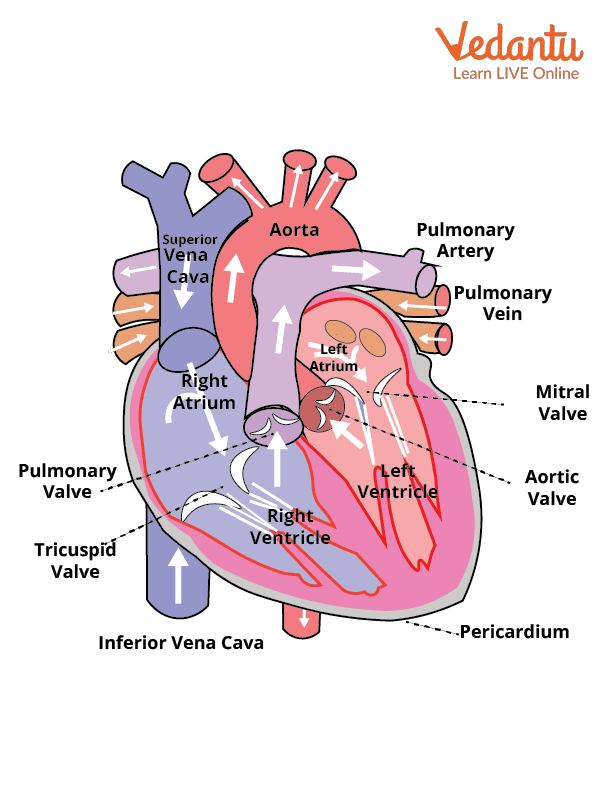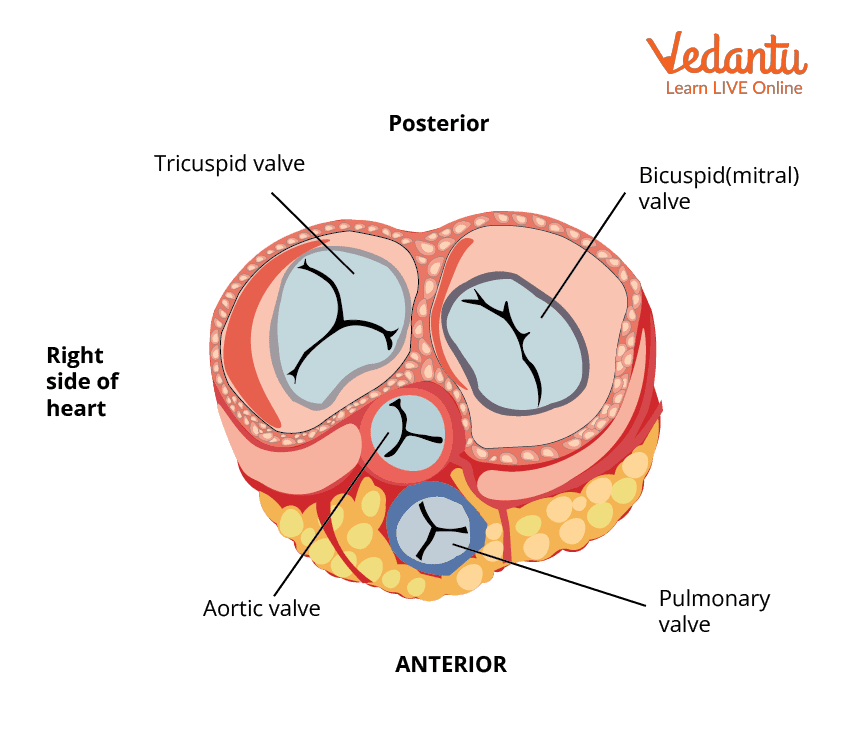How AV and Semilunar Valves Regulate Blood Flow in the Heart
By preventing the backward flow of blood from ventricles into the atria, the atrioventricular (AV) valves (mitral and tricuspid valves) divide the two atria and ventricles. Aortic and pulmonary valves, on another side, are the semilunar valves that divide the ventricles from big arteries like the aorta and pulmonary artery to stop the backward flow of blood from arteries into the ventricles.
Semilunar valves are made up of cusps that are self-supported as a result of their unique structure and position within the arteries, While, AV valves are made up of leaflets with specialised system support. The AV valves, which are attached to the ventricle walls through chordae tendineae prevent them from inverting, while in opposition to this, semilunar valves are fixed at the end of the aortic and pulmonary arteries.
Heart Valves
The purpose of heart valves is to maintain a unidirectional blood flow through the heart. Instead of being constructed of muscle, the valves are formed of stiff connective tissue layers which function as flaps. Two AV valves (mitral valve and tricuspid valve) and two semilunar valves (aortic valve and pulmonary valve) make up the four-heart valve. Due to pressure variations along both sides of the valve, the valves gently open and close. The valve's leaflets are forced to open whenever there is increased pressure behind it, allowing the blood to flow inside. However, when the pressure in front of the valve is higher, the leaflets snap shut and blood flow is blocked.

Heart Valves
AV Valves
On each side of the heart, AV valves are located between the atrium and ventricles. These valves permit both the backflow of blood into the atrium during systole and the movement of blood from the atria to the ventricles. On the right side, the AV valve is named the tricuspid valve, which has three leaflets, while on the left side the valve is called as a mitral or bicuspid valve with two leaflets.
AV valves are forced to open and blood flows into the ventricles when the atrial pressure is higher than ventricular pressure. On the other hand, AV valves close rapidly when the ventricular pressure is greater than atrial pressure. The chordae tendineae, which are fibrous connective tissues which bind to the valves, prevent them from inverting.

AV Valves
Semilunar Valves
Semilunar valves get their name from the fact that they resemble a half-moon. They are situated between two main arteries and the ventricles. The pulmonary valve is situated between the right ventricle and pulmonary artery, whereas the aortic valve is situated between the left ventricle and aorta. Semilunar valves open when the ventricular pressure rises above arterial pressure due to the ventricle’s contraction, and blood is pushed into the major arteries. On the other hand, Semilunar valves close when the ventricles relax because arterial pressure is higher than ventricular pressure. The AV valves vs semilunar valves is described in the table below:
What Is the Function of Valves?
The valves are open and close in response to the heart muscle contracting and relaxing. This permits alternating blood flow into the ventricles and atria, which helps in maintaining the proper blood flow and stops blood from flowing backwards.
Valve Disorders
Heart can suffer severe harm if the valves don't open and close properly, resulting in problems like the following:
Leaky Valve - The valve fails to close totally, allowing backward blood flow, so called regurgitation.
Stenosis - This entails restricted valve opening which doesn't open properly.
Atresia - It is a valve opening deformation that blocks the blood flow from the atria to the ventricle, or from the ventricle to the pulmonary artery or aorta.
Clinical Significance
The major purpose of heart valves is to ensure unrestricted, one-way blood circulation. Blood is pumped from the atria with low pressure to the ventricles with high pressure, which further supply the major arteries. During the constant movement of the cardiac cycle, compressive and longitudinal stresses cause valve tissue deformity, or dislocation. This deformity changes the sensitivity to physiological stimuli and susceptible genetics that can lead to valve failure.
Interesting Facts
It's interesting to note that every valve must be opened for blood to leave the chamber and closed to prevent blood from returning in the wrong direction. The valves may be harmed by disease occurrence or regular life span use.
Key Features
The major purpose of heart valves is to preserve unrestricted, one-way blood flow.
During the cardiac cycle, the AV and semilunar valves open and close, directing blood flow through the heart chambers and out to the rest of the body.
The differing framework of AV and Semilunar valves has a major influence on disorders and wellness.


FAQs on AV Valves and Semilunar Valves: Definitions, Functions & Examples
1. What are the four main valves of the human heart and how are they classified?
The human heart has four main valves that are classified into two types based on their location and structure:
- Atrioventricular (AV) Valves: Located between the atria and the ventricles. They include the tricuspid valve (between the right atrium and right ventricle) and the bicuspid or mitral valve (between the left atrium and left ventricle).
- Semilunar (SL) Valves: Located at the exit of each ventricle, where the major arteries leave the heart. They include the aortic valve (between the left ventricle and the aorta) and the pulmonary valve (between the right ventricle and the pulmonary artery).
2. What is the primary function of the AV and semilunar valves in the cardiac cycle?
The primary function of all heart valves, including the AV and semilunar valves, is to ensure unidirectional blood flow through the heart. They act as one-way gates, opening to allow blood to move forward to the next chamber or artery, and closing to prevent the backward flow (regurgitation) of blood. This precise action is crucial for maintaining pressure gradients and efficient circulation during the cardiac cycle.
3. How do atrioventricular (AV) valves and semilunar (SL) valves differ in their structure?
AV and SL valves have distinct structural differences:
- Structure of Flaps: AV valves are composed of thin flaps of tissue called leaflets. In contrast, semilunar valves are made of three half-moon shaped, pocket-like structures called cusps.
- Support System: AV valves are attached to the ventricle walls by strong, fibrous cords called chordae tendineae, which are connected to papillary muscles. This system prevents the valves from being pushed back into the atria. Semilunar valves do not have a similar support system; their cusps are self-supporting due to their shape and the pressure within the arteries.
4. Why don't the AV and semilunar valves open and close at the same time?
The AV and semilunar valves operate at opposite times due to the pressure changes during the two main phases of the cardiac cycle:
- During ventricular diastole (filling phase), the ventricles relax, and the pressure inside them drops below the atrial pressure. This causes the AV valves to open, allowing blood to flow from the atria into the ventricles, while the semilunar valves remain closed.
- During ventricular systole (pumping phase), the ventricles contract, and the pressure inside them rapidly increases, exceeding the atrial pressure. This forces the AV valves to shut. As ventricular pressure surpasses the pressure in the aorta and pulmonary artery, it forces the semilunar valves to open, ejecting blood out of the heart.
5. What prevents the AV valves from flipping backwards into the atria during strong ventricular contractions?
The AV valves are prevented from flipping backwards (prolapsing) into the atria by a specialised support structure. The valve leaflets are tethered to the inner walls of the ventricles by strong, inelastic cords called chordae tendineae. These cords are, in turn, attached to projections of the heart muscle called papillary muscles. When the ventricles contract, the papillary muscles also contract, pulling on the chordae tendineae and keeping the valve leaflets taut and securely closed.
6. Where exactly are the two semilunar valves located in the heart?
The two semilunar valves are located at the point where the major arteries exit the ventricles:
- The pulmonary valve is situated between the right ventricle and the pulmonary artery. It opens to allow deoxygenated blood to be pumped to the lungs.
- The aortic valve is situated between the left ventricle and the aorta, the body's largest artery. It opens to allow oxygenated blood to be pumped to the rest of the body.
7. What is the significance of the terms 'tricuspid' and 'bicuspid' for the AV valves?
The terms 'tricuspid' and 'bicuspid' describe the number of leaflets or flaps that make up each atrioventricular valve:
- The tricuspid valve, located on the right side of the heart, has three distinct leaflets.
- The bicuspid valve, also known as the mitral valve, is located on the left side of the heart and has two leaflets. This structural difference is related to the different pressure demands of the right and left sides of the heart.










